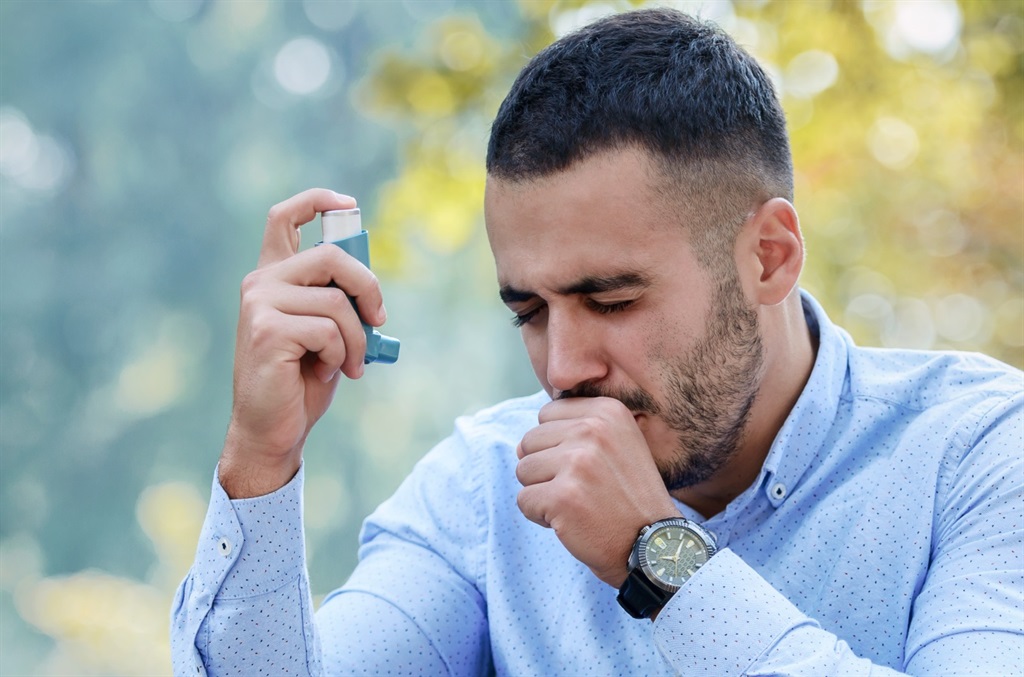
South Africa’s allergy season – August to April – is a time when asthmatics experience heightened symptoms, including coughing, chest tightness, breathlessness, and wheezing1. Overusing the blue SABA reliever pump is not the way to control these seasonal flair-ups. This approach to asthma management has been ruled risky and can trigger attacks2.
Asthma is a respiratory illness that quite literally takes your breath away. However, overusing a SABA reliever inhaler can do the same. It provides rapid, temporary relief so it becomes a crutch - but it’s actually worsening symptoms2.
When a patient is continually overusing the short-acting beta2 agonists (SABA) or blue over-the-counter symptom reliever inhaler, they are not treating the cause of their attacks - which simply put, is uncontrolled inflammation3. Asthmatics should focus on reducing asthma-induced airway inflammation with a low-dose inhaled corticosteroid (ICS)-formoterol therapy regardless of disease severity2. This combination inhaler contains an anti-inflammatory agent which reduces inflammation of the airways and provides controlled relief. This approach has been shown to be more effective in controlling asthma symptoms and preventing attacks.
According to the new global and local asthma treatment guidelines, which apply to adults and children alike, just three or more puffs of the blue inhaler per week increases a patient’s risk of asthma attacks2, 4-7. This applies to all asthmatics - regardless of whether the patient’s asthma has been diagnosed as mild, moderate, or severe. Over-reliance on the SABA pump is dangerous. It masks symptoms and does not address the underlying inflammation of the airways9.
Using three blue SABA reliever inhalers a year means your asthma is out of control. Using 12 SABA pumps a year increases the risk of asthma attacks, hospitalisations, and death10 - 13. Patients who are using this many blue pumps in a year should speak to their doctor immediately to re-examine and revise their asthma treatment plan.
It’s not only hot weather and humidity that are triggers at this time of year. Pollen, grasses, dust, smoke, and pollution are among others on a long list. Many asthma attacks and even hospitalisations are triggered by high pollen counts14.
Seasonal allergens trigger asthmatic symptoms. Put simply, it’s your body perceiving the allergen, like pollen, as an invader that needs to be attacked. The same allergens that give some people sneezing fits and watery eyes can cause an asthma attack in others. Allergic asthma is perhaps the most common asthma – especially in children15.
If you have allergic asthma, your airways are extra sensitive to certain allergens. When your immune system overreacts to the perceived threat (the allergens) the muscles around your airways tighten. The airways become inflamed and over time are flooded with thick mucus making it difficult, if not impossible, to breathe.
Controlled asthma goes beyond just not having symptoms. The impact of the illness on sleep and daily activities must also be considered. Asthma patients who have experienced these signs in the last four weeks may indicate that their asthma is not as well controlled as it could be16,17:
1. You’ve had daytime symptoms 3 or more times a week
2. Your asthma has woken you up at night
3. You have used your Blue Reliever Inhaler 3 or more times a week
4. Your asthma has limited your physical activity
Although asthma attacks are avoidable, allergy season can be challenging for asthmatics. The risk of seasonal flair-ups is high. The best course of action this allergy season is to establish control by avoiding triggers, reducing airway inflammation with low-dose inhaled corticosteroids, and breaking over-reliance on the SABA reliever inhaler2.
To assess levels of SABA over-reliance, asthma patients should take the free Reliever Reliance Test. By answering five short questions, risks and patterns of overuse can quickly be established.
Take the test today: https://bit.ly/SABAOverUseTest
References:
1. World Health Organization Asthma key facts. Available at https://www.who.int/news-room/fact-sheets/detail/asthma. Accessed August 2021.
2. Global Initiative for Asthma. Global Strategy for Asthma Management and Prevention. 2020 Update. Available at: https://ginasthma.org/wp-content/uploads/2020/06/GINA-2020- report_20_06_04-1-wms.pdf Last accessed July 2020.
3. Global strategy for Asthma Management and prevention. Global initiative for Asthma (GINA)2021. Available from https://ginasthma.org/wp-content uploads/2021/05/GINA-Main-Report-2021-V2-WMS.pdf. Accessed August 2021.
4. Burki TM. New asthma treatment recommendations. Lancet Respir Med 2019;7:479.
5. Rabe KF, Vermeire PA, Soriano JB, Maier WC. Clinical management of asthma in 1999: the asthma insights and reality in Europe (AIRE) study. Eur Respir J. 2000; 16: 802–807.
6. Asthma UK: Asthma Attacks. Available at: https://www.asthma.org.uk/advice/asthma-attacks/ Last accessed July 2020.
7. Asthma UK. Reducing prescribing errors in asthma care. Available at: https://www.asthma.org.uk/support-us/campaigns/publications/nrad-one-year-on/ Last accessed July 2020.
8. Global Initiative for Asthma. Updated 2018. www.ginasthma.org. Accessed March 2019.
9. O’Byrne PM et al. Eur Respir J. 2017;50:1701103.
10. Nwaru BI, Ekström M, Hasvold P, Wiklund F, Telg G, Janson C. Overuse of short-acting β2-agonists in asthma is associated with increased risk of exacerbation and mortality: A nationwide cohort study of the global SABINA programme. Eur Respir J 2020;55(4):1901872. https://doi.org/10.1183%2F13993003.01872-2019
11. Bloom CI, Cabrera C, Arnetorp S, et al. Asthma-related health outcomes associated with short-acting β2-agonist inhaler use: An observational UK study as part of the SABINA Global Program. Adv Ther 2020;37(10):4190-4208.
12. Price D et al. NPJ Prim Care Respir Med. 2014;24:14009.
13. Papi A et al. J Allergy Clin Immunol Pract. 2018;6:1989-1998.
14. Osborne N, Eggen B (2015) Pollen and Asthma: impacts of anthropogenic climate change. Living with Environmental Change. LWEC, NERC, Swindon, UK
15. https://www.webmd.com/asthma/allergic-asthma
16. Global Initiative for Asthma. Global Strategy for Asthma Management and Prevention, 2019. Accessed 22 July 2020. Available from: www.ginasthma.org
17. Papaioannou AI, Kostikas K, Zervas E, et al. Control of asthma in real life: still a valuable goal? Eur Respir Rev 2015;24:361–369.
Activity no : ZA-4436 | Expiry Date : 30 August 2025
This post and content is sponsored, written and provided by AstraZeneca.




 Publications
Publications
 Partners
Partners












